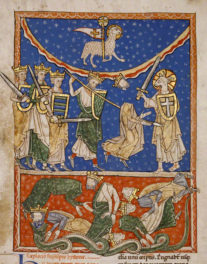
A Hyena (detail) in the Northumberland Bestiary, about 1250–60, unknown illuminator, made in England. The J. Paul Getty Museum, Ms. 100, fol. 12v. Digital image courtesy of the Getty’s Open Content Program.
Meet 18 animals of the medieval bestiary in Book of Beasts, a blog series created by art history students at UCLA with guidance from professor Meredith Cohen and curator Larisa Grollemond. The posts complement the exhibition Book of Beasts, on view at the Getty Center from May 14 to August 18, 2019. —Ed.
Notoriously hungry, the hyena has long been a source of fear throughout Africa. A nocturnal hunter and scavenger, it has been associated with sorcery, evil, and trickery. During the European Middle Ages, bestiary texts adopted the hyena as a symbol for the devil’s dark deeds.
The hyena has long had a bad reputation in African folklore and children’s tales as an untrustworthy, ugly cheater who is greedy as well as stupid. In one comic tale the hungry, slender hyena squeezes through a fence into a chicken coop and begins to eat to its heart’s content. Unlike the clever fox, who knows not to eat too much so he can sneak back out through the fence, the hyena eats all the birds and becomes too fat to escape. When morning comes, he is caught due to his own greed.
Feasting on the Dead
During the European Middle Ages, hyenas were often included in medieval bestiaries, books that told allegorical stories of Christianity through animals. Based on stories from the Physiologus, a second-century A.D. Greek compendium of animal folklore, bestiaries gave animals and their stories the weight of Christian morality. Some animals symbolized Christ; others served as warnings to protect one’s soul from the temptations of Satan.
In illustrated bestiaries, the hyena is depicted as a deceitful, dirty creature known to dwell in graveyards and dig up the recently deceased to eat their corpses. Since the hyena is a nocturnal animal, these events take place at night—emphasizing their darkness.
The hyena’s story in the bestiary is an allegory for the temptations of the devil and the importance of living a Christian life. Like the hyena in the graveyard, the devil is constantly circling. If you succumb to evil, your soul will be consumed.
Illustrations that accompany the hyena’s story often portray it devouring a corpse. In the illumination at the top of this post, we see that the hyena has already dug up a grave and now stands with all four legs on the opened coffin, biting into the body of some poor soul. Illuminations of hyenas from different regions and time periods reflect a similar design and style, because artists often referenced and copied designs from older bestiaries to make new ones.

A Hyena (detail) in a bestiary, 1200–25, unknown illuminator, made in England. Tempera colors and gold on parchment, 22 x 16 cm. The British Library, Ms. Royal 12 C XIX, fol. 11v. Digital image: British Library
Hyena as Devil
In addition to feasting on corpses, hyenas were given other wicked characteristics. They were believed to be able to change sexes, from male to female and back again, emphasizing their deceitful nature. Hyenas were also said to mimic the sound of the human voice in order to lure people out of their homes to be attacked. They could put spells on dogs and steal away their voice, and paralyze anyone by circling them three times. These stories were reminders of the power of the devil and the importance of bracing against temptation.
Consider the reputation of the hyena in comparison to that of other carnivorous mammals, such as the lordly lion. The lion and hyena are actually quite similar; they both hunt at night and scavenge when needed. Yet while the lion is regarded as noble and courageous, the hyena is seen as base and deceptive. Why? Perhaps lions are more aesthetically appealing, or their behavior easier to understand. But perhaps the role of the hyena should be seen as just that—a role in an allegorical world of good versus evil, where someone has to play the bad guy.
Further Reading
Payne, Ann. Medieval Beasts. New York: New Amsterdam Books, 1990.
Text of this post © Jessica Sheppard-Reynolds. All rights reserved.
See all posts in this series »





Wonderful article. I quite enjoyed it. Thank you.